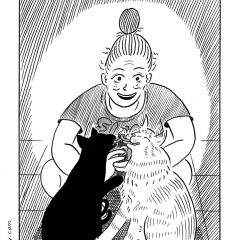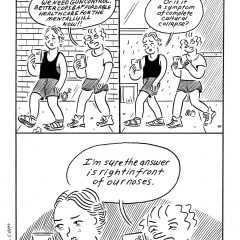In the short story, “The Library of Babel,” Jorge Luis Borges describes an infinite library of books containing every possible permutation of the letters of the alphabet, where librarians move endlessly from chamber to chamber reading texts and searching for meaning.
The overwhelming volume of information easily available in the modern, digital era has virtually reached the chaotic tumult of words described by Borges, and seems to have affected each of the eight Philadelphia artists exhibited in Database, currently up at Little Berlin. The mixed-media show based on curator Angela McQuillan’s prompt to create a work based on the visualization of information includes works ranging from carefully calculated and technical imagery to raw, personal expressions that mirror the digital experience.
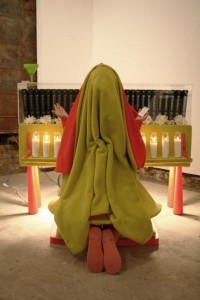
Jerry Kaba’s “Our Encyclopedia of Little Berlin” is a quasi-religious funereal altar to the Encyclopedia Britannica, a 29-volume encyclopedia that has been completely phased out of its usefulness. Kaba presents the encyclopedia under a glass case, like the embalmed body of a Communist leader, and surrounded by prayer candles. The piece includes a praying nun, who hands out prayer cards to viewers and kneels before what Kaba called the “go-to source of information for 250 years.” (In 2010, the print edition of the encyclopedia was discontinued.) Kaba, who said that as a child he frequently referred to the encyclopedia for school reports, said that the piece combines elements of various religions to imagine a futuristic worship of data made manifest.
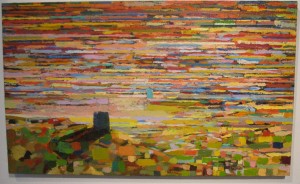
Alyssa Johnson’s “I See You” is a three-part piece: a massive painting representing a personal event in her life, Johnson’s carefully blacked-out diary pages which detail that exact event, and two volumes of her journals, which include a description of the methodology by which the artist adapted her experiences into the painting. By sharing these autobiographical details, Johnson supplies the components that are typically left offstage at art shows and creates a work that also makes the process part of its subject. The viewer is both drawn to and slightly intimidated by the exposure of the personal impetus behind the painting on display, but ultimately very much informed by the chaotic pattern of colors that these life experiences have become on canvas.
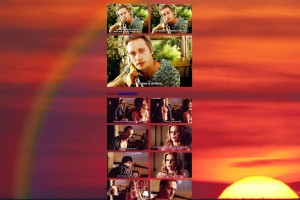
Beth Heinly’s Tru-Love.net is a live projection of the artist’s Tumblr fanpage about the HBO vampire romance series True Blood. The page uses Java scripts to update with animated gifs and images from top True Blood fan sites. Apart from the artist’s obvious deep commitment to the series, the Tumblr partly operates like an anonymous data generator, feeding off an almost endless supply of images and text that can be automatically and effortlessly created and sustained almost forever.
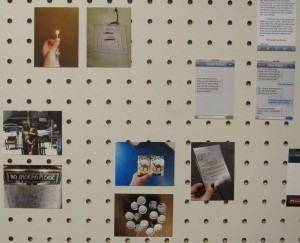
Alison Feldish’s “Can I Smoke in Here?” is a wry self-portrait made up of an array of images from her iPhone – images of phone calls, text message conversations, and photographs of daily life. In the artist’s statement, she states that the idea for the piece came from the thought that these digital images would be all that was left of her if she were to disappear one day.
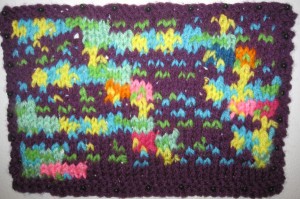
Jessie Hemmons is either well-known or infamous, depending on who you ask, for her local yarn-bombings, such as the multi-colored banners adorning the exterior of the Museum of Fine Arts’ Perelman building to announce the Craft Spoken Here exhibit. For this show, she knit an “infome,” which is a raw visual representation of internet data designed by Lisa Jevbratt. Jevbratt’s infome-generator site can send out web-crawling software robots from any homepage the user selects, collecting information about interlinking webpages and their content and producing a color-coded, abstract report of digital information.
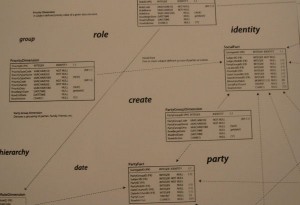
Dennis Towers’ “Portrait” [This is a correction per the comment from Dennis Towers below] depicts traits and qualities linked to obscure numerical codes. The traits all seem to be characteristics of a person, making this a sort of digital portrait, but untouched by human hands and entirely incomprehensible without a computer there to interpret the code. The result is completely abstract and evokes the absolute meaninglessness of digital information when exposed to the human eye.
George Purkins’ “NES Genomics” is an impressive and technical project depicting something akin to the genome code of all Nintendo games ever created. Purkins developed a code similar to that used to map human DNA into a genome code and applied it to video game files, mapping the “tree of life” of the game files.
Lee Tusman’s “Intrusive noise policy – Gallery Rest Room Entryway Transition Sounds,” is a series of all the audio files that came up from a single Google search. Again, the random interlinking online of vastly different types of files comes into play, as well as the commercially dominated nature of the internet – after all, many of the audio files in the loop are advertisements or movie trailers.
Ultimately, the show stimulates questions about how these different artists responded to the concept of the database in our data-rich digital era. Instead of trying to completely master the technology, or giving up before the futility of the task, these artists have responded in new and unexpected ways, whether by reaching out and utilizing technology to harvest a massive yield of information – useless or not – or by imitating the patterns of logic proposed by the linkages of the internet and other new media.
Database, curated by Angela McQuillan, will be up at Little Berlin through June 23.



